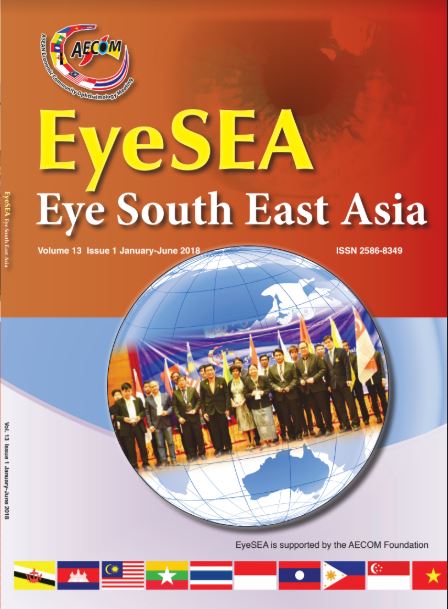Modified endoscope-assisted vitrectomy for missed intraocular foreign body.
Main Article Content
Abstract
Background: Reporting a case of missed IOFB managed by novel approach of modified endoscope-assisted vitrectomy using Endoscopic cyclophotocoagulation fiber-optic probe for IOFB retrieval.
Case report: Mr MY, a 58 years old Malay gentleman with no underlying medical illness presented with five-month history of left eye gradual onset, painless blurry vision. Symptoms were preceded by a history of high-velocity foreign body which entered the left eye while cutting grass with rotating blade cutter without eye protection, of which was self-treated with over-the-counter topical medications. No history of eye redness or floaters. Systemic examination was unremarkable. On presentation, vision was 6/6 OD and 6/36 OS. Left eye demonstrated rusty pigments on anterior lens capsule with anterior subcapsular cataract with retro-lental streak vitreous opacity and underlying flat retina. Right eye was normal. CT orbit showed radio-dense foreign body in left globe over posterior and infero-lateral to lens. Patient underwent left eye phacoemulsification and vitrectomy surgery. Intra-operatively noted siderosis of lens capsule with no intraocular foreign body (IOFB) found. Repeated imaging showed retained IOFB. Subsequently, he underwent modified endoscope-assisted vitrectomy using Endocyclophotocoagulation (ECP) fiber-optic probe which retrieved fibrosis-covered IOFB infero-temporal to posterior capsule.
Conclusion: Endoscope-assisted vitrectomy is safe and useful in IOFB retrieval by bypassing anterior segment opacities and visualization of anterior structures. The use of ECP probe in endoscope-assisted vitrectomy in this case, which has never been reported before, offers an innovative alternative in places where conventional ophthalmic endoscope is not readily available.
Conflict of interest: We declare that we have no conflict of interest
Article Details
References
2. Sneed RS, Weingeist TA. Management of siderosis bulbi due to a retained iron containing intraocular foreign body. Ophthalmology 1990;97:375–9.
3. Hope-Ross M, Mahon GJ, Johnston PB. Ocular siderosis. Eye 1993;7:419–25.
4. Rathod R and Mieler WR. An update on the management of intraocular foreign bodies. Retinal Physician; 2011: 2-8.
5. Yeh S, Colyer MH, and Weichel ED. Current trends in the management of intraocular foreign bodies. Current Opinion in Ophthalmology 2008; 19 (3): 225–233.
6. H. S. Sandhu and L. H. Young. Ocular siderosis. International Ophthalmology Clinics 2013; 53 (4): 177–184.
7. Rusnak S., Kozova M., Belfinova S., Ricarova R. Transscleral Extraction of an Intraocular Foreign Body without PPV. EVRS Meeting; 2009.
8. Sabti KA, Raizada S. Endoscope-assisted pars plana vitrectomy in severe ocular trauma. Br J Ophthalmol 2012; 96: 1399-1403.
9. Park JH, Lee JH, Shin JP, Kim IT, and Park DH. Intraocular foreign body removal by viscoelastic capture using discovisc during 23-gauge microincision vitrectomy surgery. Retina 2013; 33(5):1070–1072.
10. Singh R., Bhalekar S., Dogra M. R., Gupta A. 23-gauge vitrectomy with intraocular foreign body removal via the limbus: an alternative approach for select cases. Indian Journal of Ophthalmology. 2014;62(6):707–710. doi: 10.4103/0301-4738.116458.
11. Yuksel K., Celik U., Alagoz C., Dundar H., Celik B., Yazıcı A. T. 23 Gauge pars plana vitrectomy for the removal of retained intraocular foreign bodies. BMC Ophthalmology. 2015;15, article 75 doi: 10.1186/s12886-015-0067-2.
12. Uram M. Endoscopic cyclophotocoagulation in glaucoma management. Curr Opin Ophthalmol. 1995;6:19–29.
13. Seibold LK, Soohoo JR, and Kahook MY. Endoscopic cyclophotocoagulation. Middle East Afr J Ophthalmol 2015; 22(1): 18–24.
14. Thrope H. Ocular endoscope: instrument for removal of intravitreous non-magnetic foreign bodies. Trans Am Acad Ophthalmol Otolaryngol 1934; 39: 422.
15. Ben-nun J. Cornea sparing by endoscopically guided vitreoretinal surgery. Ophthalmology 2001; 108: 1465-1470.
16. Nicoara SD, Irimescu I, Calinici T, Cristian C. Intraocular foreign bodies extracted by pars plana vitrectomy: clinical characteristics, management, outcomes and prognostic factors. BMC Ophthalmol. 2015;15:151.
17. Valmaggia C, Baty F, Lang C, Helbig H. Ocular injuries with a metallic foreign body in the posterior segment as a result of hammering: the visual outcome and prognostic factors. Retina. 2014; 34(6): 1116–1122.
18. Bai HQ, Yao L, Meng XX, Wang YX, Wang DB. Visual outcome following intraocular foreign bodies: a retrospective review of 5-year clinical experience. Eur J Ophthalmol. 2011; 21(1): 98–103.
19. Chow DR, Garretson BR, Kuczynski B, Williams GA, Margherio R, Cox MS, Trese MT, Hassan T, Ferrone P. External versus internal approach to the removal of metallic intraocular foreign bodies. Retina. 2000; 20(4): 364–369.
20. Marra KV, Yonekawa Y, Papakostas TD. Indications and techniques of endoscope assisted vitrectomy. J Ophthalmic Vis Res. 2013; 8(3): 282-290.


